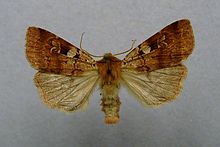- Ingrailed Clay
-
Ingrailed Clay 
Scientific classification Kingdom: Animalia Phylum: Arthropoda Class: Insecta Order: Lepidoptera Family: Noctuidae Genus: Diarsia Species: D. mendica Binomial name Diarsia mendica
Fabricius, 1775The Ingrailed Clay (Diarsia mendica) is a moth of the family Noctuidae. It is distributed through most of Europe.
This species occurs in a huge range of colour types and is one of the most variable species in the family. Forewing colour ranges from very pale straw-coloured to very dark brown, with the pale forms predominant in the south of the range and the darker forms prevalent further north. The best way of identifying the species is the relatively (to most other noctuids) short and broad forewings usually marked with two large stigmata. The hindwings are pale to dark grey. The wingspan is 28-36 mm. This moth flies at night from June to August [1] and is attracted to light.
The larva is brown with black triangular markings along the side. It feeds on a wide range of plants (see list below). The species overwinters as a larva.
- ^ The flight season refers to the British Isles. This may vary in other parts of the range.
Contents
Recorded food plants
- Calluna - Heather
- Campanula - Harebell
- Crataegus - Hawthorn
- Lactuca - Lettuce
- Pinaceae
- Rubus - Bramble
- Rumex - Dock
- Salix - Willow
- Vaccinium
Subspecies
- D. m. borealis - Scandinavia, north and central Russia
- D. m. mendica - Central, south and west Europe
- D. m. orkneyensis - Orkney
- D. m. thulei - Shetland
References
- Chinery, Michael Collins Guide to the Insects of Britain and Western Europe 1986 (Reprinted 1991)
- Skinner, Bernard Colour Identification Guide to Moths of the British Isles 1984
External links
Categories:- Diarsia
- Animals described in 1775
Wikimedia Foundation. 2010.
